La Constancia, Esmeralda
1913 issues
The La Constancia mine, Esmeralda, is situated in the municipality of Sierra Mojada in the extreme west of Coahuila.
On 4 September 1913 Enrique Salas wrote to the company's manager, Lázaro de la Garza, at Torreón, about the loan that the company had made to Teniente Colonel Apolonio Cano, the chief of the Constitutional forces which had taken over EsmeraldaLG papers, 9-H-4, letter Salas, Esmeralda, to de la Garza, Torreón, 4 September 1913, so the first issue might have been caused by a combination of the shortage of change and the need to satisfy the rebel forces, as detailed in the El Imparcial article of April 1914.
We know of one issue of one and five pesos. Both these notes were issued by the Compañía Minera La Constancia on 21 August 1913 and canceled by Gullermo Purcell y Cía., Sucs. in Saltillo four years later on 27 July 1917.
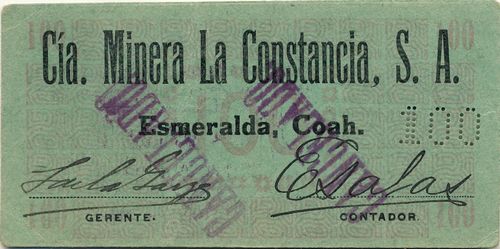
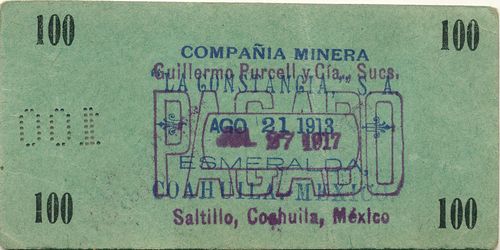 M1117b $1 Cía. Minera La Constancia
M1117b $1 Cía. Minera La Constancia
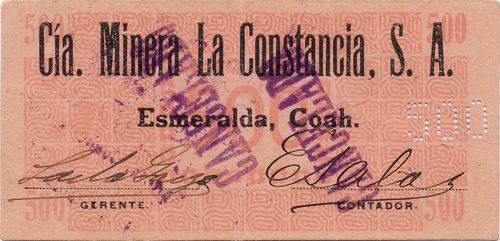
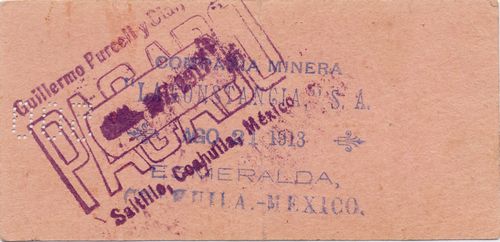 M1117.1 Cía. Minera La Constancia
M1117.1 Cía. Minera La Constancia
These are signed by Lázaro de la Garza as Gerente and Enrique Salas as Contador.
|
Lázaro de la Garza was a U.S. citizen born in Laredo who had established himself in Torreón, where he had become wealthy by selling mining properties and managing a mining enterprise. When Villa captured Torreón and levied a war tax of three million pesos against the city, he named a three-man commission, one of whom was de la Garza to collect the forced loanCarothers to Secretary of State, 17 October 1916, D. F. file no 812.00/19596, microcopy 274, RDS, RG 59, NARA; Blanford report, 17 June 1916, 7BI. De la Garza also handled the bank-on-bank cheques in Torreón. Villa was so pleased with de la Garza’s performance that he appointed him his commercial and financial agent (Agente Financiero de la División del Norte), with headquarters in Ciudad JuárezEl Paso Morning Times, 24 February 1914. There he was involved in the production of Villa's dos caritas. De la Graza served as president of the Banco del Estado de Chihuahua, and was director of the Comisión de la Hacienda in Torreón. He was also president of L. de la Garza & Co., Inc., an import, export and commission business organized in New York in 1915; other officers were Rafael L. Hernández and José F. Farías. De la Garza moved from Ciudad Juárez to New York to handle munitions supplies for Villa’s army. Together with Felix Sommerfeld and three uncles of Francisco Madero (Alberto, Alfonso and Ernesto) de la Garza faithfully supplied Villa until the summer of 1915, when Villa lost at Celaya and León. Together with Sommerfeld, de la Garza cobbled together a large munitions contract for 15 million cartridges. When Villa could no longer pay Sommerfeld and his German backers decided to sell off the contract to the highest bidders. Some of the deliveries went to Obregón in the autumn of 1915. The rest went to France in the winter of 1915 and through 1916. Since German agents could not appear connected to this deal, de la Garza handled the entire administration of the contract and developed sticky fingers. As soon as the French had signed the delivery contract in October 1915, de la Garza sued the Western Cartridge Company for the return of his deposit of $65,000. Franklin Olin, the head of Western Cartridge refunded the money to him without much hesitation. However, the down payment belonged to the Madero brothers who, in turn, owed that amount to the División del Norte. De la Garza was unsure what to do with the money and kept it in his account. By the summer of 1916 the contract had made de la Garza the $65,000 deposit (paid by Villa and the Maderos) and $75,000 in commissions from the French. De la Garza had some minor expenses for legal fees and the administration of the contract but made somewhere around $140,000 in total through this arrangement. Immediately after the contract came to its conclusion in the summer of 1916, de la Garza moved himself and his family, including his brother, Vidal, to Los Angeles. There, he bought a $100,000 ($200,000 if one believes the Los Angeles TimesLos Angeles Times, ) mansion with cash and settled down. His wife, Esther, brought over $93,000 with her in cash from Torreón. It is likely that this money represented earnings and other cash assets from his investments in Mexico. Most of his property had been expropriated by Carranza, who by the fall of 1915 had full control over Chihuahua and Torreón. As a Villista, de la Garza could expect no mercy and no reimbursement. He officially “retired” from the revolution when he moved to Los Angeles and lived lavishly on the interest of his “savings”. The revolution had made him an even richer man than he already was in 1911. It did not take long for Villa and the Madero brothers to catch on. Alberto Madero sued him in Los Angeles in June 1916. The case dragged on until 1918, when it was dismissed on a technicality, namely that Villa was an enemy of the United States (since the attack on Columbus) and, therefore, could not recover any money north of the border. Villa was furious. He sent de la Garza a letter in 1919, asking him to work for him again and that everything would be forgiven, but intending to try and arrest and execute his former treasurer. De la Garza wrote to his friend, Leon Canova, that he would stay as far away from Villa as he could. When Villa realized that he could not touch de la Garza, he threatened to kidnap twelve Americans that he would trade for the merchant. After Villa was assassinated in 1923 his brother, Hipólito, kept up the pressure and sued de la Garza into the 1930s. A court in Ciudad Juárez finally convicted de la Garza in 1933 and issued a warrant for his arrest. De la Garza defended himself with all means at his disposal all the way to the Mexican Supreme Court, which overturned the conviction. While de la Garza succeeded in keeping the stolen money, he paid a hefty, non-material price for his crime. Alberto Madero and Hipólito Villa ruined his reputation with continued lawsuits and negative press coverage that branded him a traitor to the revolution. Later in life, he tried to re-establish a meaningful business in Mexico, but his effort came to nothing. Not even a network of American politicians and financiers could help him overcome the reputation of a swindler who had sold out his country. He died in Torreón in August 1939. |
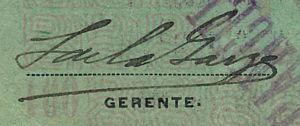 |
|
Enrique Salas There are frequent references to Salas in de la Garza's correspondence. In August 1914 de la Garza was writing about the mining taxes for the Cía. Minera La Constancia to be paid by SalasLG papers, 9-H-10, letter José Rivera, Torreón, to de la Garza, Ciudad Juárez, transcribing a letter from Salas of Cia Minera La Constancia about a cheque from de la Garza, 17 August 1914; LG papers, 1-L- , letter de la Garza, Los Angeles, to Villareal, Mexico City, concerning mining taxes and de la Garza's arrangement of a loan in New York for the Banco del Estado de Chihuahua, 19 August 1914; LG papers, 9-E- , letter de la Garza, Los Angeles, to Vidal de de la, Chihuahua, 19 August 1914. Salas was at Esmeralda in June 1915LG papers, 9-B-57 , telegram Salas, Esmeralda, to José Garza Zertuche, El Paso, 28 June 1915. De la Garza was still at Esmeralda in July 1915 (LG papers, box 9 H letter Cia Minera La Constancia, Saltillo, to de la Garza, Esmeralda. 1 July 1915; LG papers box 9 H letter de la Garza, Esmeralda, to Guillermo Purcell y Cia. Sucs., Saltillo. 8 July 1915) but by 27 August 1915 he was in El PasoLG papers, 5-I-37, telegram de la Garza to Salas, El Paso, 27 August 1915 asking him to tell Félix not to take the rifles out of the Aduana until Raymundo Navarro arrives. It seems that Salas also fell foul of Villa. By December 1916 he was at San Buenventura, Coahuila, writing to de la Garza in Los Angeles and referring to Villa's mistreatment of himself and his familyLG papers, 9-H-28, letter Salas, San Buenaventura, to de la Garza, Los Angeles, 7 December 1916. He continued to work for de la Garza, including reporting on the potential purchase of minesLG papers, 9-H- , letter Salas, San Buenaventura, to de la Garza, Los Angeles, 2 January 1917; LG papers, 9-H- , letter Salas, San Buenaventura, to de la Garza, Los Angeles, 12 March 1917; LG papers, 9-H- , letter Salas, San Buenaventura, to de la Garza, Los Angeles, 15 April 1917. He was back at Esmeralda in 1921LG papers, 9-H-5, telegram Salas, Esmeralda, to Prestamos y Descuentas, S. A., Ciudad. Juárez, 30 September 1921(?), asking for funds from ASARCO. |
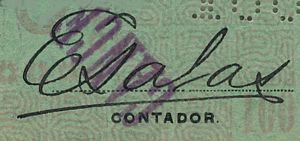 |
1914 issues
We know of a 50c note datestamped 5 February 1914 and a $1 note[image needed].
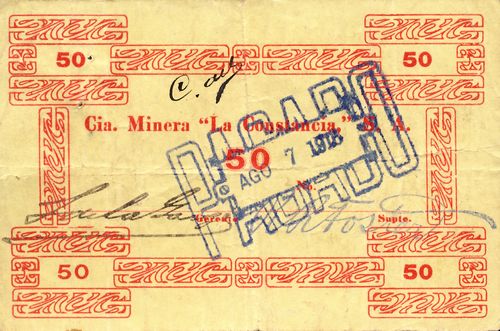
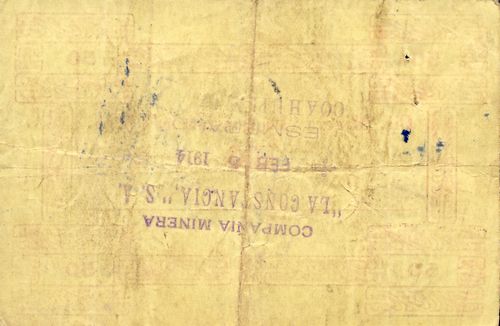 M1116 50c Cía. Minera "La Constancia"
M1116 50c Cía. Minera "La Constancia"
These now has R. R. Foster as Superintendente.
|
R. R. Foster was a native of Taylor, Texas. He served as a mining engineer at la Constantia and in August 1913 remained behind when most Americans left the Sierra Mojada because of the rebellionEl Paso Herald, 12 August 1913. He is also frequently mentioned in de la Garza's correspondence. In his later years he had interests in Arizona and New Mexico, and died at Silver City, New Mexico, on 23 July 1945The Mining Journal, 15 August 1915 |
 |
Another series.
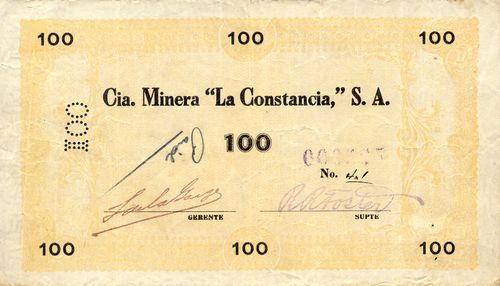 M1118 $1 Cía. Minera "La Constancia"
M1118 $1 Cía. Minera "La Constancia"
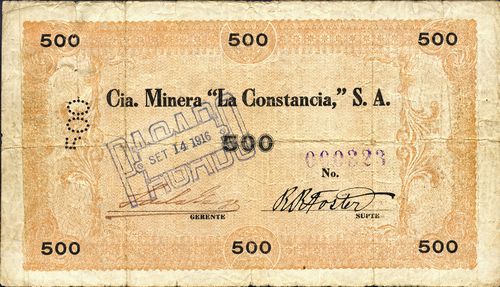 M1119 $5 Cía. Minera "La Constancia"
M1119 $5 Cía. Minera "La Constancia"
| from | to | total number |
total value |
||
| $1 | includes number 00352[ ]5 | ||||
| $5 | includes number 000223 |
These were also signed by de la Garza and Foster.
1915 and 1916 issues
Further issues are known from 1915 and 1916. One group is for specific amounts in Constitutionalist money, to be used in the marketplace in Sierra Mojada. These were typed on reused sheets of paper, including chits issued by the company store (tienda de raya).
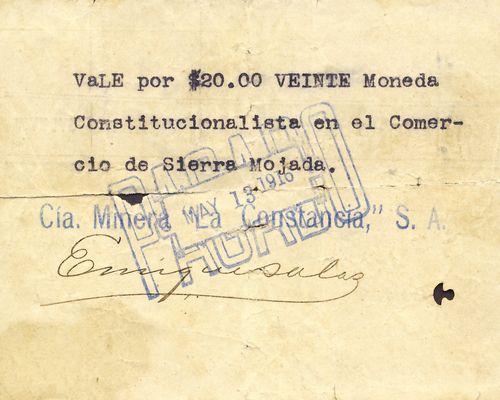
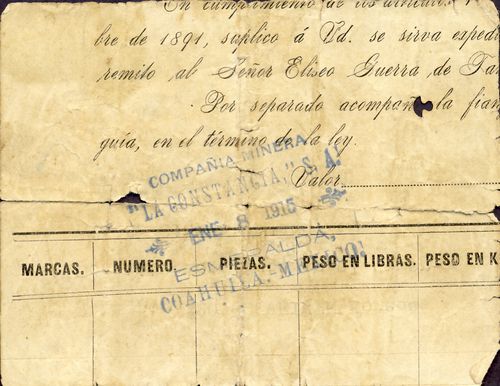 M1113 $20 Cía. Minera "La Constancia"
M1113 $20 Cía. Minera "La Constancia"
We also have examples of vales from "La Esmeralda" for specific amounts ($5, $10 and $20), with a space for filling in the name of the payee, payable in merchandise in the company's store.
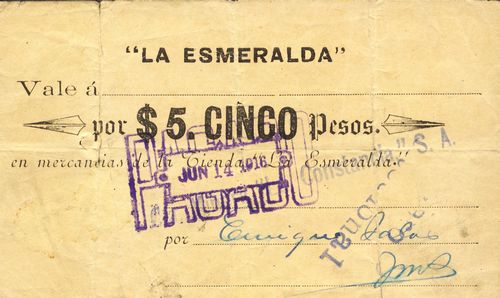
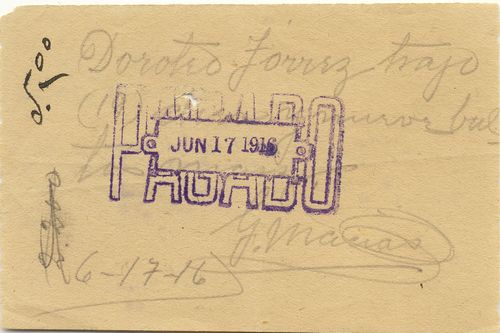 M1104 $5 "La Esmeralda"
M1104 $5 "La Esmeralda"
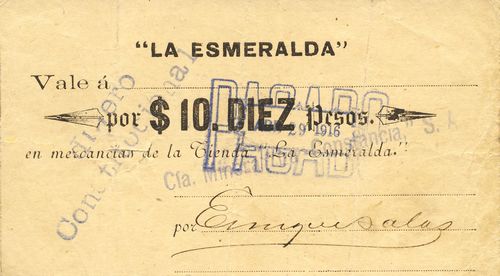
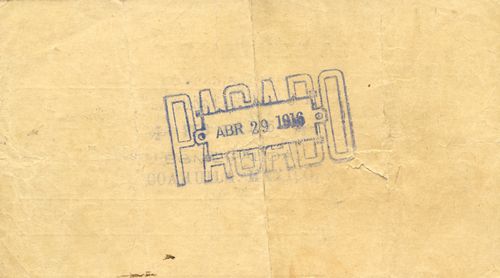 M1105 $10 "La Esmeralda"
M1105 $10 "La Esmeralda"
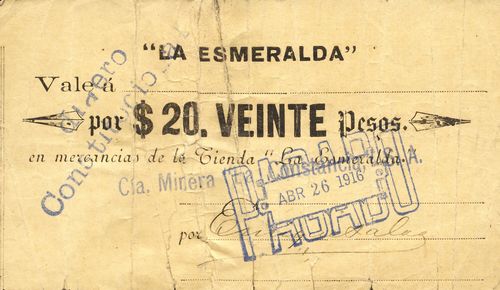
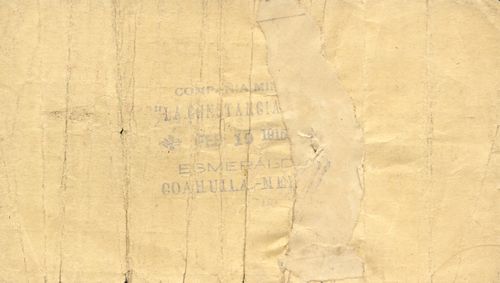 M1106 $20 "La Esmeralda"
M1106 $20 "La Esmeralda"
Another group are of provisional vales for specific amounts in Carranza’s infalsificable money. Note that the denominations go up to $100, so these were not just for paying wages but for every manner of commercial transactions.
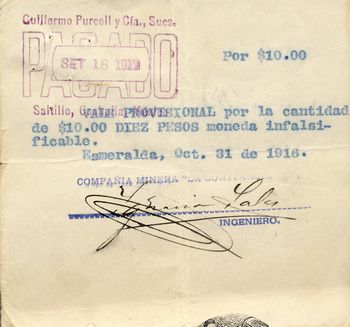 M1112 $10 Compania Minera "La Constancia"
M1112 $10 Compania Minera "La Constancia"
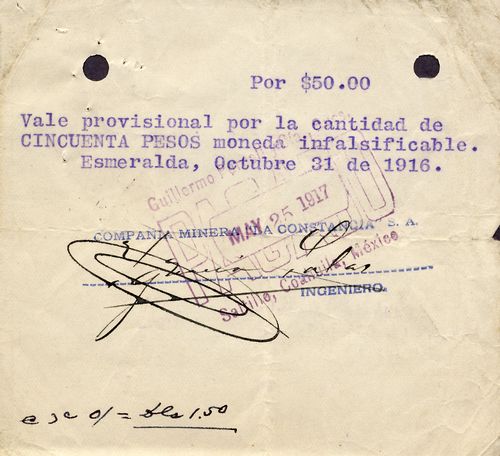 M1114 $50 Compania Minera "La Constancia"
M1114 $50 Compania Minera "La Constancia"
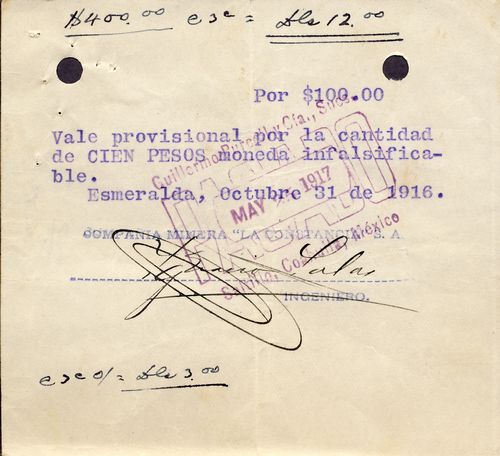
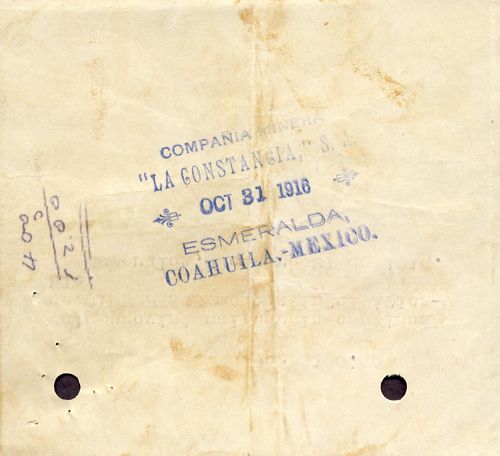 M1115 $100 Compania Minera "La Constancia"
M1115 $100 Compania Minera "La Constancia"
These are signed by Ignacio Salas, as engineer.
| Ignacio Salas |
